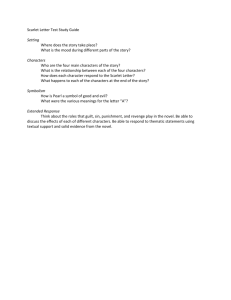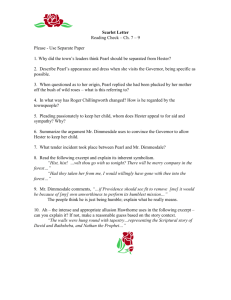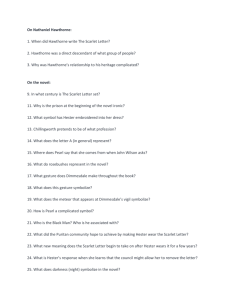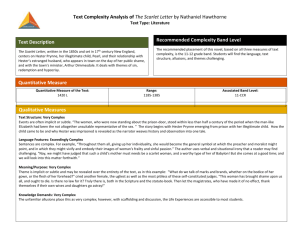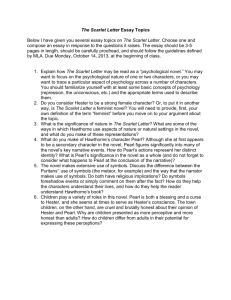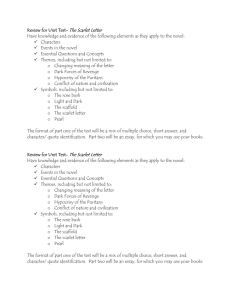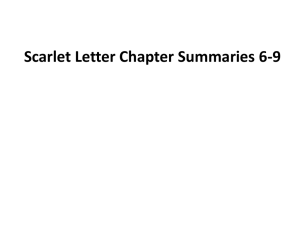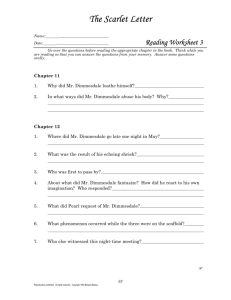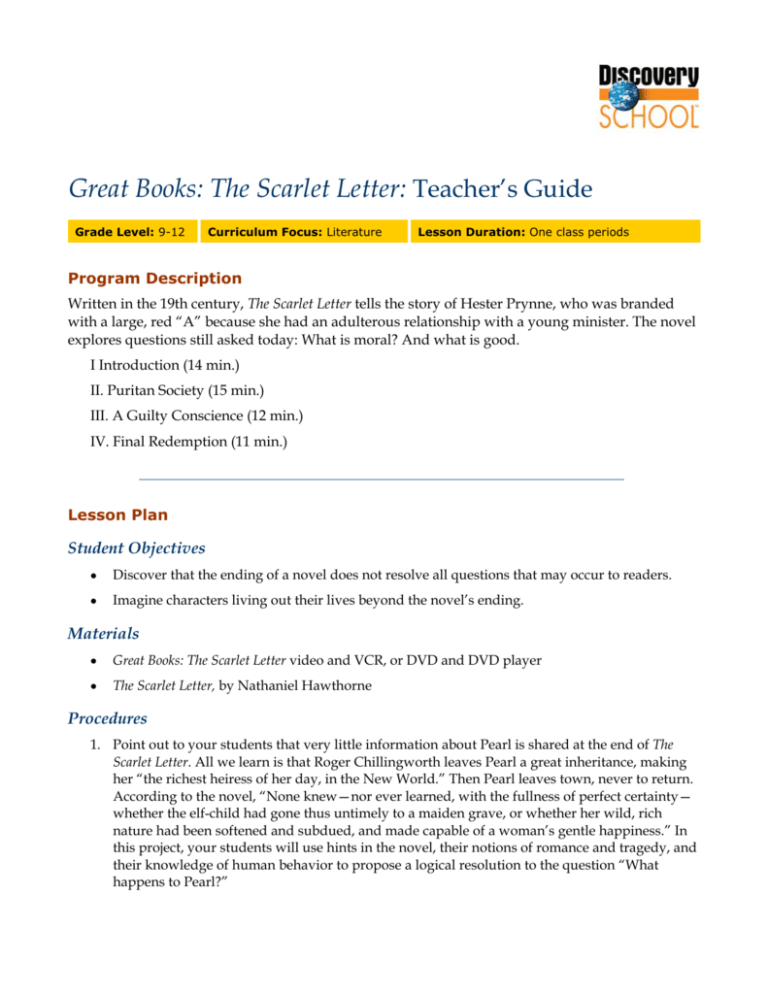
Great Books: The Scarlet Letter: Teacher’s Guide
Grade Level: 9-12
Curriculum Focus: Literature
Lesson Duration: One class periods
Program Description
Written in the 19th century, The Scarlet Letter tells the story of Hester Prynne, who was branded
with a large, red “A” because she had an adulterous relationship with a young minister. The novel
explores questions still asked today: What is moral? And what is good.
I Introduction (14 min.)
II. Puritan Society (15 min.)
III. A Guilty Conscience (12 min.)
IV. Final Redemption (11 min.)
Lesson Plan
Student Objectives
•
Discover that the ending of a novel does not resolve all questions that may occur to readers.
•
Imagine characters living out their lives beyond the novel’s ending.
Materials
•
Great Books: The Scarlet Letter video and VCR, or DVD and DVD player
•
The Scarlet Letter, by Nathaniel Hawthorne
Procedures
1. Point out to your students that very little information about Pearl is shared at the end of The
Scarlet Letter. All we learn is that Roger Chillingworth leaves Pearl a great inheritance, making
her “the richest heiress of her day, in the New World.” Then Pearl leaves town, never to return.
According to the novel, “None knew—nor ever learned, with the fullness of perfect certainty—
whether the elf-child had gone thus untimely to a maiden grave, or whether her wild, rich
nature had been softened and subdued, and made capable of a woman’s gentle happiness.” In
this project, your students will use hints in the novel, their notions of romance and tragedy, and
their knowledge of human behavior to propose a logical resolution to the question “What
happens to Pearl?”
Great Books: The Scarlet Letter: Teacher’s Guide
2
2. Establish what your students know from the novel about Pearl as a child. Ask them to describe
Pearl based on how the author presented this character. Ask the following questions:
•
What does Pearl’s appearance tell readers?
•
What do we learn about Pearl from how she talks and acts?
•
What do we learn about Pearl from what other people (including the author) say or
suggest about her?
3. Having established some sense of Pearl, ask your students to discuss the following questions
that relate to her life beyond the end of the novel:
•
How might Pearl’s childhood experiences affect her emotions and her activities once she
leaves New England?
•
What life skills will Pearl have to learn as a young woman?
•
Under what conditions might Pearl marry or have a child?
•
How likely is it that Pearl might take out her anger on people in her new community?
What antisocial actions might she take?
•
How likely is it that Pearl would grow beyond her anger? How would Pearl display
normality?
•
If Pearl survives, how much communication do you think she will have with her
mother?
•
What role could Pearl play in another community? Might she be a witch, a religious
leader who dispenses mercy and punishment, or a recluse?
•
If Pearl survives and has a child, what do you think she will tell the child about Hester,
Dimmesdale, or Chillingworth? What will she say about her own childhood?
4. After the class discussion, give students the following options for writing their ideas.
•
Write a short story with Pearl, age 18, as the main character.
•
Write a letter from Pearl, age 18, to her mother.
•
Write a scene between Pearl, age 18, and her mother, whom she goes to visit.
•
Write a doctor’s report on the cause of Pearl’s death at age 18.
5. Let each student share the written product with the class. Ask for comments on the credibility
and authenticity of Pearl’s portrayal in each piece.
6. Discuss the following: We may not be certain of an author’s motives, but we can judge how an
author’s decision affects us as readers. How do you feel about how the novel ends in relation to
Pearl? Explain your reasons.
Published by Discovery Education. © 2005. All rights reserved.
Great Books: The Scarlet Letter: Teacher’s Guide
3
Assessment
Use the following three-point rubric to evaluate students’ work during this lesson.
•
3 points: Students actively participated in class discussions; created a credible and authentic
extension of the novel; wrote smooth prose or a natural-sounding first-person voice; made
no errors in grammar, usage, or mechanics.
•
2 points: Students somewhat participated in class discussions; created a credible and
authentic extension of the novel; wrote mostly smooth and natural-sounding prose; and had
some errors in grammar, usage, or mechanics.
•
1 point: Students did not participate in class discussions; did not produce a credible and
authentic extension of the novel or did not make a sincere effort to do so; wrote
insufficiently smooth or unnatural-sounding prose; and made many errors in grammar,
usage, and mechanics.
Vocabulary
hypocrisy
Definition: A feigning to be what one is not or to believe what one does not, especially the false
assumption of an appearance of virtue or religion
Context: The Scarlet Letter is a slow, tortuous dance of guilt, hypocrisy, and vengeance that ends
in tragedy.
illegitimate
Definition: Not recognized as lawful offspring; born of parents not married to each other
Context: Pearl, Hester’s illegitimate child, grows into a lively and perceptive child.
imp
Definition: A small demon; a mischievous child
Context: Throughout the novel, Pearl is portrayed as sort of an imp who behaves rather badly.
retribution
Definition: Something given or exacted in recompense; punishment
Context: It was meant for retribution, too, a torture to be felt, a constant reminder in the midst of
a troubled joy.
scaffold
Definition: A platform on which a criminal is executed or punished
Context: After Hester’s appearance on the scaffold, she and Pearl are taken to prison.
Published by Discovery Education. © 2005. All rights reserved.
Great Books: The Scarlet Letter: Teacher’s Guide
4
Academic Standards
Mid-continent Research for Education and Learning (McREL)
McREL’s Content Knowledge: A Compendium of Standards and Benchmarks for K-12 Education
addresses 14 content areas. To view the standards and benchmarks, visit link:
http://www.mcrel.org/compendium/browse.asp
This lesson plan addresses the following national standards:
•
Language Arts—Writing: Uses the general skills and strategies of the writing process, Uses
the stylistic and rhetorical aspects of writing, Uses grammatical and mechanical conventions
in written compositions, Gathers and uses information for research purposes; Reading: Uses
reading skills and strategies to understand and interpret a variety of literary texts
The National Council of Teachers of English (NCTE)
The National Council of Teachers of English (NCTE) and the International Reading Association
have developed national standards to provide guidelines for teaching the English language arts. To
view the standards online, go to http://www.ncte.org/about/over/standards/110846.htm
This lesson plan addresses the following NCTE standards:
•
Students apply a wide range of strategies to comprehend, interpret, evaluate, and appreciate
texts. They draw on their prior experience, their interactions with other readers and writers,
their knowledge of word meaning and of other texts, their word identification strategies,
and their understanding of textual features (e.g., sound-letter correspondence, sentence
structure, context, graphics).
•
Students adjust their use of spoken, written, and visual language (e.g., conventions, style,
and vocabulary) to communicate effectively with a variety of audiences and for different
purposes.
•
Students employ a wide range of strategies as they write and use different writing process
elements appropriately to communicate with different audiences for a variety of purposes.
•
Students apply knowledge of language structure, language conventions (e.g., spelling and
punctuation), media techniques, figurative language, and genre to create, critique, and
discuss print and non-print texts.
Support Materials
Develop custom worksheets, educational puzzles, online quizzes, and more with the free teaching tools
offered on the Discoveryschool.com Web site. Create and print support materials, or save them to a
Custom Classroom account for future use. To learn more, visit
•
http://school.discovery.com/teachingtools/teachingtools.html
Published by Discovery Education. © 2005. All rights reserved.
Great Books: The Scarlet Letter: Teacher’s Guide
5
DVD Content
This program is available in an interactive DVD format. The following information and activities are
specific to the DVD version.
How To Use the DVD
The DVD starting screen has the following options:
Play Video—This plays the video from start to finish. There are no programmed stops, except by
using a remote control. With a computer, depending on the particular software player, a pause
button is included with the other video controls.
Video Index—Here the video is divided into four parts (see below), indicated by video thumbnail
icons. Watching all parts in sequence is similar to watching the video from start to finish. Brief
descriptions and total running times are noted for each part. To play a particular segment, press
Enter on the remote for TV playback; on a computer, click once to highlight a thumbnail and read
the accompanying text description and click again to start the video.
Curriculum Units—These are specially edited video segments pulled from different sections of the
video (see below). These nonlinear segments align with key ideas in the unit of instruction. They
include onscreen pre- and post-viewing questions, reproduced below in this Teacher’s Guide. Total
running times for these segments are noted. To play a particular segment, press Enter on the TV
remote or click once on the Curriculum Unit title on a computer.
Standards Link—Selecting this option displays a single screen that lists the national academic
standards the video addresses.
Teacher Resources—This screen gives the technical support number and Web site address.
Video Index
I. Introduction (14 min.)
An overview of the story told in The Scarlet Letter and the moral and social issues it addressed and
an introduction to author Nathaniel Hawthorne.
II. Puritan Society (15 min.)
A look at 17th-century Puritan society and a discussion of Hester Prynne and her daughter, Pearl,
and what Hawthorne intended to reveal through their characters.
III. A Guilty Conscience (12 min.)
As the plot of The Scarlet Letter unfolds, Arthur Dimmesdale deteriorates and Hester attempts to
save him. A look at the characters of Dimmesdale and Roger Chillingworth and Puritan society’s
fear of witchcraft.
Published by Discovery Education. © 2005. All rights reserved.
Great Books: The Scarlet Letter: Teacher’s Guide
6
IV. Final Redemption (11 min.)
Hester and Dimmesdale reunite but are unable to break free of their sins. Critics and scholars
discuss the ending to The Scarlet Letter and the book’s lasting legacy.
Curriculum Units
1. Introduction: The Scarlet Letter
Pre-viewing question
Q: What does it mean to be a conscientious objector?
A: A conscientious objector has come to mean a person who refuses to serve in the military or
participate in warfare due to religious or moral reasons. People have defined Hester Prynne as an
early conscientious objector because by her actions she refuses to partake in a Puritanical society.
Post-viewing question
Q: In what ways do you see the themes of The Scarlet Letter being applied today?
A: Answers will vary.
2. An Adulteress’ Tale
Pre-viewing question
Q: Do you think Hester received a fitting punishment for her adultery?
A: Answers will vary.
Post-viewing question
Q: In what ways does Hester come to embody the Puritan ideals for a woman?
A: Hester becomes a humble nurse for sick townsfolk. She spends her time embroidering clothing
and refuses to join the witches’ circle, instead choosing to set a good example for her daughter. She
forgives Dimmesdale for not standing by her when she is punished for their affair.
3. A Family Reunited
Pre-viewing question
Q: Why do you think Hester chose not to reveal the name of Pearl’s father?
A: Answers will vary.
Post-viewing question
Q: How does Dimmesdale’s shame affect his power as a preacher?
A: The more his shame overwhelms him and the more Dimmesdale longs for redemption, the more
powerful and fiery his preaching becomes. His torment is interpreted as passion for God and his
parishioners admire him even more because they have no notion of what is truly driving him.
4. Escaping the Letter
Pre-viewing question
Q: Do you think Dimmesdale is an honorable man or a hypocrite?
A: Answers will vary.
Published by Discovery Education. © 2005. All rights reserved.
Great Books: The Scarlet Letter: Teacher’s Guide
7
Post-viewing question
Q: Why do you think Hester returns to the village and wears her scarlet letter until the end of her
life? Do you think the book should have ended differently?
A: Answers will vary.
5. Puritan Society
Pre-viewing question
Q: Why was Hester Prynne a threat to the Puritans?
A: She broke their laws and went against the uniform beliefs of their society.
Post-viewing question
Q: Why did the Puritans settle in America?
A: The Puritans were not looking for religious freedom, as is commonly thought. Rather they were
looking for a place where they could set up a godly society, one that existed according to their laws
and religious regulations.
6. A Victorian Author
Pre-viewing question
Q: Why do you think The Scarlet Letter sold so few copies during Hawthorne’s lifetime despite
having earned literary praise?
A: Answers will vary.
Post-viewing question
Q: What were some of the common Victorian literary symbols used in The Scarlet Letter?
A: Possible answers: The forest represented freedom during the day, and at night it represented
evil. The prison and cemetery represent oppression and sorrow.
Published by Discovery Education. © 2005. All rights reserved.

